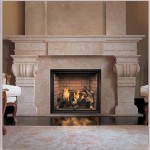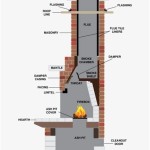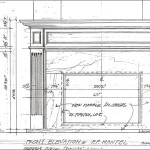Living Room Furniture Layout With Fireplace And TV On Opposite Walls
Arranging furniture in a living room with a fireplace and a television on opposite walls presents a unique design challenge. This configuration often requires careful consideration of focal points, traffic flow, and viewing angles to create a comfortable and functional space. Successfully navigating this layout involves balancing the aesthetic appeal of the fireplace with the practical requirements of television viewing, ensuring that neither element dominates the room while both remain accessible and enjoyable.
Many homeowners grapple with this specific layout, as it can easily lead to an imbalanced or awkward room arrangement. The key lies in understanding the principles of spatial design and applying them strategically to maximize the room's potential. It is important to consider the room's dimensions, the size of the furniture pieces, and the desired atmosphere when planning the layout. A well-executed design will not only visually enhance the space but also improve its functionality and comfort for everyday use.
Balancing Focal Points: Fireplace vs. Television
The primary challenge in a living room with a fireplace and television on opposite walls is to create a sense of balance between these two prominent focal points. The fireplace, typically a symbol of warmth and relaxation, often serves as a natural gathering place. The television, on the other hand, tends to draw attention due to its dynamic visuals and audio. Effectively managing these competing elements is crucial for a harmonious living space.
One approach is to establish a hierarchy, subtly emphasizing one focal point over the other. This can be achieved through varying the visual weight of the surrounding décor. For instance, a grand fireplace with a detailed mantel and flanking bookshelves will naturally draw more attention than a simple television mounted on the wall. Conversely, a larger television or a dedicated entertainment unit can become the dominant focal point if that is the desired effect.
Another technique is to use color and lighting to direct the eye. A bright, colorful artwork above the fireplace can attract attention, while dimming the lights around the television can help to minimize its visual impact when it's not in use. Decorative elements, such as plants or sculptures, can also be strategically placed to create visual pathways that lead the eye from one focal point to the other, ensuring a smooth transition between them.
Symmetry can also play a crucial role in balancing the room. Positioning matching chairs or lamps on either side of the fireplace and the television can create a sense of order and equilibrium. This symmetrical arrangement helps to visually anchor both focal points, preventing either from feeling out of place or overpowering the other. However, it's important to avoid being overly rigid with symmetry, as it can sometimes feel too formal or contrived. A touch of asymmetry, such as a slightly different arrangement of cushions or accessories, can add a more relaxed and personalized feel to the space.
Furniture Arrangement Strategies for Optimal Viewing and Conversation
The arrangement of furniture in a living room with opposing fireplace and television walls should facilitate comfortable viewing of the television while also encouraging conversation and social interaction. This requires careful consideration of seating placement and traffic flow.
A common strategy is to position a sofa facing the television, with additional seating, such as armchairs or loveseats, arranged around it. This creates a primary viewing area focused on the television. However, care must be taken to ensure that the seating arrangement does not completely ignore the fireplace. Angling the armchairs slightly towards the fireplace can help to incorporate it into the conversation area, allowing people to comfortably interact with each other while still maintaining a view of the television.
Another approach is to create two distinct seating areas: one focused on the television and one centered around the fireplace. This can be achieved by dividing the room into zones using rugs or furniture placement. A larger rug can define the television viewing area, while a smaller rug can anchor a separate seating arrangement around the fireplace. This zoning technique allows people to choose the area that best suits their needs, whether they want to watch television or relax by the fire.
Traffic flow is another important consideration. Furniture should be arranged to allow for easy movement around the room, without obstructing pathways or creating bottlenecks. Adequate space should be left between furniture pieces to allow people to walk comfortably. This is particularly important in smaller living rooms, where space is at a premium. A narrow console table behind the sofa can serve as a buffer zone, preventing people from walking directly in front of the television screen. Additionally, consider using smaller, more maneuverable furniture pieces that can be easily rearranged to accommodate different activities or gatherings.
The distance between the sofa and the television is also crucial for comfortable viewing. A general rule of thumb is to multiply the screen size of the television (measured diagonally in inches) by 1.5 to determine the ideal viewing distance in inches. For example, a 50-inch television would require a viewing distance of approximately 75 inches (6.25 feet). Adjusting the furniture placement to achieve this optimal viewing distance will help to prevent eye strain and ensure a more enjoyable viewing experience.
Integrating Storage and Minimizing Glare
Beyond furniture arrangement, incorporating storage solutions and mitigating glare are essential for a functional and aesthetically pleasing living room with a fireplace and television on opposite walls. Storage helps to keep the space organized and clutter-free, while minimizing glare ensures optimal television viewing.
Storage solutions can be integrated in a variety of ways. Built-in shelving units flanking the fireplace can provide ample space for books, decorative items, and media accessories. This not only adds visual interest to the fireplace wall but also helps to balance the visual weight of the television on the opposite side of the room. Alternatively, a console table beneath the television can offer storage for media consoles, gaming systems, and other electronic devices. Choosing storage solutions that complement the style of the room and the furniture will create a cohesive and harmonious look.
Minimizing glare on the television screen is crucial for comfortable viewing, especially in rooms with large windows or bright natural light. Strategically placing curtains or blinds can help to control the amount of light entering the room. Blackout curtains are particularly effective at blocking out sunlight, but lighter-colored curtains or blinds can also help to diffuse the light and reduce glare. Another option is to use anti-glare screen protectors, which can be applied directly to the television screen to minimize reflections.
The placement of lamps and other light fixtures can also influence glare. Positioning lamps strategically can help to illuminate the room without creating harsh reflections on the television screen. Avoid placing lamps directly in front of the television or behind the seating area, as this can create distracting glare. Instead, position lamps to the sides or slightly behind the seating area to provide ambient lighting without interfering with television viewing.
Consider the color palette of the room when addressing glare issues. Lighter colors tend to reflect more light, while darker colors absorb more light. Using darker colors on the walls behind the television can help to reduce glare and improve contrast. However, it's important to balance this effect with the overall aesthetic of the room, as a room that is too dark can feel gloomy and unwelcoming. A combination of light and dark colors, strategically placed, can create a visually appealing and functional space.
Finally, the type of finish on the furniture can also contribute to glare. Furniture with glossy finishes tends to reflect more light than furniture with matte finishes. Choosing furniture with matte finishes can help to minimize reflections and create a more comfortable viewing environment. This is particularly important for coffee tables and other surfaces that are positioned in front of the television.

20 Living Room Layout With Fireplace And Tv On Opposite Walls Livingroom Family Arrangements

How To Position Your Fireplace Furniture Together

How To Arrange Furniture With Two Focal Walls Emily Henderson

Got A Room With Opposite Focal Points Here S How To Arrange It Michael Helwig Interiors

How To Arrange Living Room Furniture With A Tv And Fireplace

Living Room Layouts With Fireplace Tvs Direct Fireplaces

Got A Room With Opposite Focal Points Here S How To Arrange It Michael Helwig Interiors

Living Room Layout With Fireplace And Tv On Opposite Walls Plan Floor Plans

How To Arrange Living Room Furniture With A Fireplace And Tv Cow

Living Room With Fireplace And Tv On Opposite Walls Livingroom Layout Awkward Small








